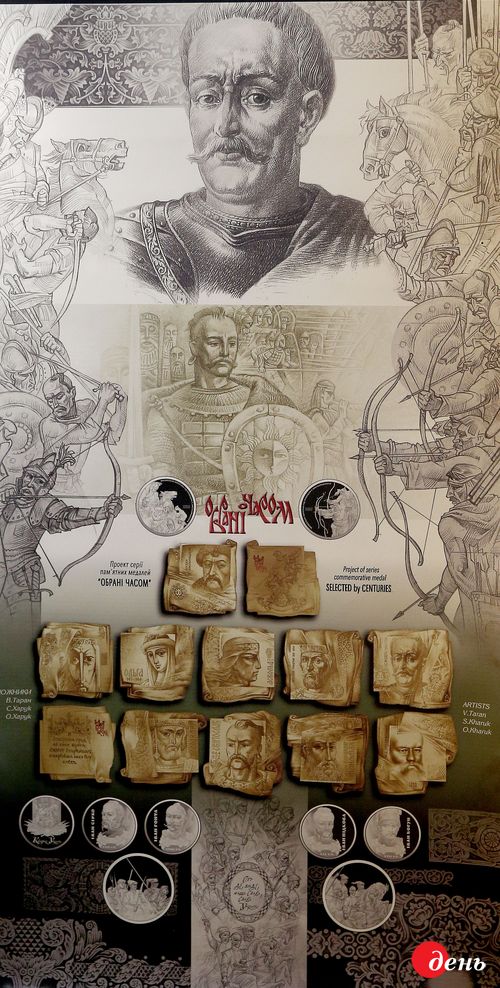The evolution of hryvnia
Ukrainian money, valuable and beautiful, is displayed at a new exhibition in Kyiv
A twisted neck accessory dated 11th-12th centuries and made of precious metal is actually the hryvna, which, according to the opinion of many scientists, gave the name to the Ukrainian currency. Together with about 300 rare items, it was presented at the National Museum of History of Ukraine within the framework of the exhibition “From Hryvna to Hryvnia.” The project was dedicated to the 20th anniversary of the money reform and introduction of the national currency, and it shows the history of creation of the present-day currency and memorable coins of the country.
WHOSE MONEY IS LIGHTER?
At the end of the 10th century Ancient Rus’ started to make its own coins of gold and silver. They depicted the prince and the trident on them and decorated them with inscriptions. “Such coins were made for 25 years. Then so-called ‘coinless’ period came, when hryvnas, large unchangeable pieces of silver were used on our territory. The coin hryvna of Kyiv type weighed about 160 grams, Chernihiv and Novgorod types – about 180 grams,” Zinaida Zraziuk, head of the numismatics department at the National Museum of History of Ukraine, said.

Later they started to make coins again. The exhibition shows the money of the late 14th century, which was made in Podil, Novgorod-Siversky, and Kyiv principalities. Some of them are on display for the first time, because it has become possible to attribute them only recently.
LARGE SIZE, HUGE VALUE
For several centuries Ukraine has been a part of other states and didn’t make coins of its own. Its own currency symbols emerged during the Ukrainian People’s Republic in 1917. Hryvnias as big as a school exercise book sheet are very refined, because they were created by famous artists, in particular Vasyl Krychevsky and Heorhii Narbut.

But this money has existed only for several years, and then Ukraine lost its independence, till 1991. “At the initial stage after acquiring independence we didn’t have any gold reserve and the capacity to establish the national currency, and we also had to protect the provision market. So at first coupon-karbovanets were issued, and then – coupon-karbovanets of multiple use. There was an incredible inflation and we needed a currency which would take the blow – that was their purpose,” Zraziuk explained. In 1995 even the memorable coin of the value of 200,000 Karbovanets, called “The victory in the Great Patriotic War of 1941-45,” was made at the Moscow Monetary Court.
LUHANSK MINT
The decree of the Presidium of the Verkhovna Rada “On the national currency in Ukraine” was approved back in the end of 1991. Then they were thinking on how to call the money. According to Zraziuk, they considered many versions: for the bills – Ukrainian dollars, karbovanets; for the coins – shahs, kopeks, stotynkas, and vekshas.
The first banknotes were printed in 1992 in Canada, and they were waiting for their time in the storehouses of the National Bank of Ukraine for four years. And in 1996 economy stabilized, the bank and loan system was established, as well as the gold-currency reserve, and they started to use the new currency.

The first Ukrainian kopeks were made in Luhansk. The temporary mint was located at the machine-tool factory. “The machines at this factory were used to produce cartridges, so it was simple to reequip them for making coins. But the impresses for these machine-tools were made abroad – in England and Italy,” Zraziuk says. The museum employee adds that in the period of the UNR, it was planned to issue our own coins, and namely then they paid attention to this enterprise, and then to the Luhansk Cartridge Factory.
The banknote factory in Ukraine was launched in 1994, the full-fledged mint – in 1998. The NBU mint is located at a sleeping area of Kyiv, in Troieshchyna. Zraziuk noted that the orders for making coins for other countries are fulfilled there too.
So, don’t miss the chance to see tens of unique items, in particular, the artistic memorable coins and even stamps of the NBU monetary court, which generally are never brought out of the doors of this institution – at the exhibition “From Hryvna to Hryvnia,” which will be open at the National Museum of History of Ukraine till the end of the year.






